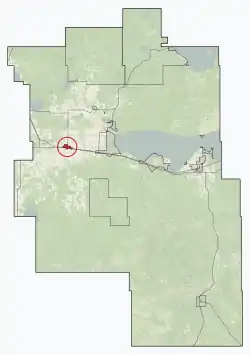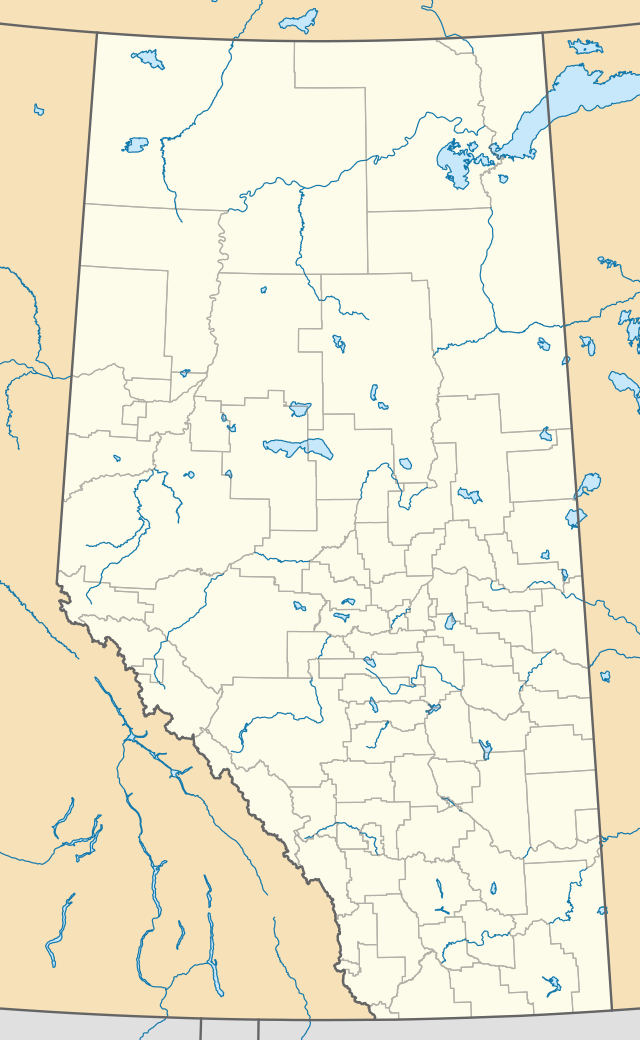High Prairie
High Prairie is a town in northern Alberta, Canada within Big Lakes County. It is located at the junction of Highway 2 and Highway 749, approximately 89 km (55 mi) northeast of Valleyview and 118 km (73 mi) west of Slave Lake.
High Prairie | |
|---|---|
Town | |
| Town of High Prairie | |
| Motto(s): Gateway to the Peace Country | |
 Location in Big Lakes County | |
 High Prairie Location of High Prairie in Alberta  High Prairie High Prairie (Canada) | |
| Coordinates: 55°25′57″N 116°29′10″W | |
| Country | Canada |
| Province | Alberta |
| Region | Northern Alberta |
| Planning region | Upper Athabasca |
| Municipal district | Big Lakes County |
| Incorporated[1] | |
| • Village | April 6, 1945 |
| • Town | January 10, 1950 |
| Government | |
| • Mayor | Brian Panasiuk |
| • Governing body | High Prairie Town Council |
| Area (2016)[3] | |
| • Land | 7.22 km2 (2.79 sq mi) |
| Elevation | 595 m (1,952 ft) |
| Population (2016)[3] | |
| • Total | 2,564 |
| • Density | 355.3/km2 (920/sq mi) |
| Time zone | UTC−07:00 (MST) |
| • Summer (DST) | UTC−06:00 (MDT) |
| Postal code span | T0G 1E0 |
| Area code(s) | 780, 587, 825 |
| Highways | Highway 2 Highway 749 |
| Website | Official website |
History
Describes the nature of the surrounding countryside. Post office opened in 1910. Early name, Prairie River.[5] In 1914, the alignment of the Edmonton, Dunvegan and British Columbia Railway, later known as the Northern Alberta Railway, was chosen to go through High Prairie instead of Grouard to the northeast.[6] As a result, many residents and businesses from Grouard relocated to High Prairie once the Edmonton, Dunvegan and British Columbia Railway was built.[6]
With an estimated population of 600 people, High Prairie was incorporated as a village on April 6, 1945[7] and subsequently as a town on January 10, 1950.[7]
Demographics
| Year | Pop. | ±% |
|---|---|---|
| 1946 | 643 | — |
| 1951 | 1,141 | +77.4% |
| 1956 | 1,743 | +52.8% |
| 1961 | 1,756 | +0.7% |
| 1966 | 2,241 | +27.6% |
| 1971 | 2,354 | +5.0% |
| 1976 | 2,281 | −3.1% |
| 1981 | 2,506 | +9.9% |
| 1986 | 2,817 | +12.4% |
| 1991 | 2,932 | +4.1% |
| 1996 | 2,907 | −0.9% |
| 2001 | 2,737 | −5.8% |
| 2006 | 2,750 | +0.5% |
| 2011 | 2,600 | −5.5% |
| 2016 | 2,564 | −1.4% |
| Source: Statistics Canada [8][9][10][11][12][13][14][15][3] | ||
In the 2016 Census of Population conducted by Statistics Canada, the Town of High Prairie recorded a population of 2,564 living in 949 of its 1,116 total private dwellings, a -1.4% change from its 2011 population of 2,600. With a land area of 7.22 km2 (2.79 sq mi), it had a population density of 355.1/km2 (919.8/sq mi) in 2016.[3]
In the 2011 Census, High Prairie had a population of 2,600 living in 972 of its 1,069 total dwellings, a -6.6% change from its 2006 adjusted population of 2,785. With a land area of 7.92 km2 (3.06 sq mi), it had a population density of 328.3/km2 (850.2/sq mi) in 2011.[16] The population of the town, according to its 2007 municipal census is 2,836.[17]
Economy
High Prairie's main industries include agriculture, forestry, oil and gas, and service industry.
One of its main employers was the Tolko OSB Mill that was built in 1995 however the plant was closed in February, 2007, putting more than a 100 employees out of work. West Fraser Mills purchased the Buchanon lumber mill in 2014 and is now the main employer for High Prairie with 150 employees.
Attractions
Due to its proximity to the western shores of Lesser Slave Lake, High Prairie has a thriving tourism industry, particularly in the warmer summer months. There are many attractions at the lake, including events such as the Golden Walleye Classic.
Winagami Lake Provincial Park, approximately 12 kilometres (7.5 mi) to the north of High Prairie, and Kimiwan Lake, approximately 49 kilometres (30 mi) to the northwest, are attractions for bird-watching enthusiasts. Winagami Lake and Kimiwan Lake are within the general area where three major migration paths meet – the Central Flyway, the Mississippi Flyway, and the Pacific Flyway.
Government
High Prairie is governed by a town council, a mayor and six council members, each of whom serve four-year terms. Federally, it is part of the Fort McMurray—Athabasca electoral district. In the next federal election, it will become part of the newly formed riding of Peace River—Westlock.[18]
Media
Media outlets serving High Prairie and surrounding area include CKVH The Fox, CIRE-TV (the local community channel), and the South Peace News, a local community newspaper.
Notable people
- Tom Lysiak, former professional hockey player
- Randy Ragan, former professional soccer player
- cheyanne turions, curator, artist, writer[19]
Recognition
In 2001, High Prairie was recognized for its state-of-the-art water treatment system and it was awarded 4 'blooms' by Communities in Bloom,[20] a non-profit organization that encourages environmental responsibility and beautification in Canadian communities.
In popular culture
The news satire program This Is That had an episode in which they discussed a (fictional) attempt by High Prairie to attract tourism by inventing a fake accent.[21]
References
- "Location and History Profile: Town of High Prairie" (PDF). Alberta Municipal Affairs. October 7, 2016. p. 316. Retrieved October 13, 2016.
- "Municipal Officials Search". Alberta Municipal Affairs. September 22, 2017. Retrieved September 25, 2017.
- "Population and dwelling counts, for Canada, provinces and territories, and census subdivisions (municipalities), 2016 and 2011 censuses – 100% data (Alberta)". Statistics Canada. February 8, 2017. Retrieved February 8, 2017.
- "Alberta Private Sewage Systems 2009 Standard of Practice Handbook: Appendix A.3 Alberta Design Data (A.3.A. Alberta Climate Design Data by Town)" (PDF) (PDF). Safety Codes Council. January 2012. pp. 212–215 (PDF pages 226–229). Retrieved October 8, 2013.
- Hamilton, William (1978). The Macmillan Book of Canadian Place Names. Toronto: Macmillan. p. 26. ISBN 0-7715-9754-1.
- Brown, Richard. "A Town Bypassed: Grouard, Alberta, and the Building of the Edmonton, Dunvegan and British Columbia Railway". The Archivist. Ottawa: National Archives of Canada (17). ISSN 0705-2855. Retrieved 2011-06-12.
- "Town of High Prairie". Town of High Prairie. Retrieved 2011-09-28.
- "Table 5: Population of urban centres, 1916-1946, with guide to locations". Census of the Prairie Provinces, 1946. Volume I: Population. Ottawa: Dominion Bureau of Statistics. 1949. pp. 397–400.
- "Table 6: Population by sex, for census subdivisions, 1956 and 1951". Census of Canada, 1956. Volume I: Population. Ottawa: Dominion Bureau of Statistics. 1958.
- "Table 9: Population by census subdivisions, 1966 by sex, and 1961". 1966 Census of Canada. Western Provinces. Population: Divisions and Subdivisions. Ottawa: Dominion Bureau of Statistics. 1967.
- "Table 3: Population for census divisions and subdivisions, 1971 and 1976". 1976 Census of Canada. Census Divisions and Subdivisions, Western Provinces and the Territories. Population: Geographic Distributions. Ottawa: Statistics Canada. 1977.
- "Table 2: Census Subdivisions in Alphabetical Order, Showing Population Rank, Canada, 1981". 1981 Census of Canada. Census subdivisions in decreasing population order. Ottawa: Statistics Canada. 1982. ISBN 0-660-51563-6.
- "Table 2: Population and Dwelling Counts, for Census Divisions and Census Subdivisions, 1986 and 1991 – 100% Data". 91 Census. Population and Dwelling Counts – Census Divisions and Census Subdivisions. Ottawa: Statistics Canada. 1992. pp. 100–108. ISBN 0-660-57115-3.
- "Population and Dwelling Counts, for Canada, Provinces and Territories, and Census Divisions, 2001 and 1996 Censuses – 100% Data (Alberta)". Statistics Canada. Retrieved 2019-05-25.
- "Population and dwelling counts, for Canada, provinces and territories, and census subdivisions (municipalities), 2006 and 2001 censuses – 100% data (Alberta)". Statistics Canada. January 6, 2010. Retrieved 2019-05-25.
- "Population and dwelling counts, for Canada, provinces and territories, and census subdivisions (municipalities), 2011 and 2006 censuses (Alberta)". Statistics Canada. 2012-02-08. Retrieved 2012-02-08.
- Alberta Municipal Affairs (2009-09-15). "Alberta 2009 Official Population List" (PDF). Retrieved 2010-09-14.
- Alberta Redistribution Commission. "Alberta Electoral Districts". Retrieved 2014-02-01.
- "cheyanne turions". Chicago Architecture Biennial. Retrieved 24 August 2019.
- Communities in Bloom Archived 2007-09-27 at the Wayback Machine - Participants
- Lila MacLellan (March 27, 2015). "A new way to attract tourists: fake accents and dying languages". Quartz. Retrieved 2020-02-22.